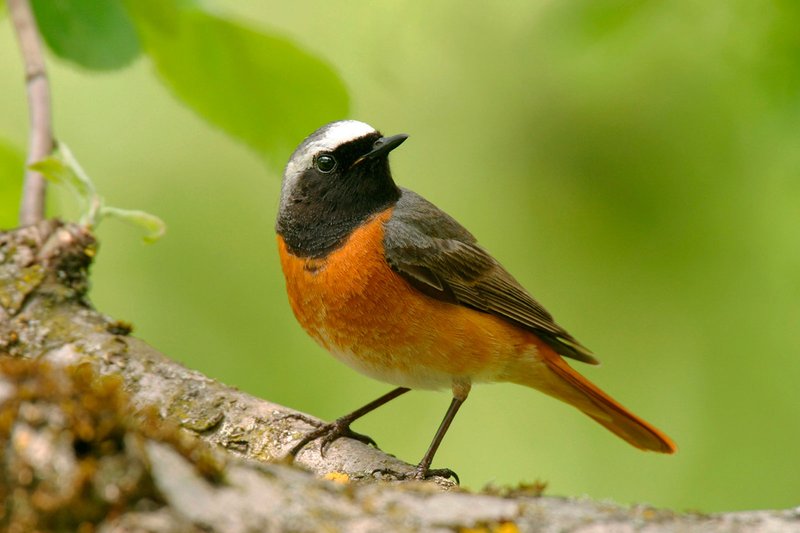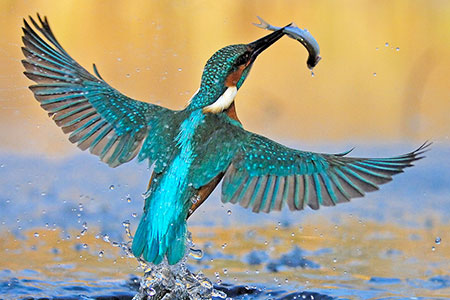Between taiga and savannah
Splendour through wear and tear
The common redstart and black redstart (Phoenicurus ochruros) are the only representatives of the redstart genus in Europe. They differ in that the plumage of the common redstart is much richer in contrast. The sides of its face and its throat are black, its forehead is white, and its breast a bright orangey-red, especially during the breeding season. However, this splendour is not the result of a change of plumage.
Instead, the light-coloured tips of the feathers, moulted in late summer, wear off over the winter. This allows the “underlying” colour to come into its own just in time for the breeding season. The females are inconspicuously coloured and, like the young birds, lack the black colouring on the sides of their faces.
Where the “red” in its name comes from is self-evident. The bird’s appearance is reflected even more in its scientific name, “Phoenicurus”, which comes from the Ancient Greek phoinix- (φοίνιξ = red) and -ouros (ουρά = tail).
Commuters between taiga and savannah
The common redstart has a large breeding range in Europe. It stretches from Lake Baikal to the Atlantic coast, and from the boreal zone north of the Arctic Circle to the southern tip of the Italian “boot”. Here, this long-distance migrant is only a summer visitor. It spends the winter in the Sahel region of West and Central Africa. The autumn migration begins in mid-July. The birds migrate at night and mainly singly. The start and duration of migration are timed so that the animals only arrive in the African savannah at the end of the rainy season, when a richly laid table awaits them.
Back at the nesting site
The birds return to their breeding grounds mainly in April. The males arrive a few days earlier than the females in order to secure the best territories in advance. These are about one hectare in size and aggressively defended against conspecifics. Common redstarts are loyal to a particular territory and - with an average age of three to five years - can occupy a territory for several years. When a female arrives in the territory, the most promising breeding sites are shown off to her as a potential future mate - with the help of song and the splendour of a brightly coloured breast and a fanned tail.
A choosy chap
The common redstart naturally colonises sparse forests. This is also reflected by the current focal point of their distribution, in the mixed coniferous forests of Finland. In central Europe, it is most likely to be found in alluvial landscapes, in dry and warm mixed deciduous forests, but also in the decay phases of old-growth mixed beech forests. However different the boreal mixed coniferous forest and a mixed beech forest may be in the decay phase, they do have something in common. In both habitats, breeding sites and feeding habitats for the bird are closely interlinked.
The common redstart is a semi-cavity-nesting bird that breeds in tree hollows as well as in rock crevices or on root plates etc. Old-growth, sparse and structurally rich stands with lots of deadwood and biotope trees provide many cavities and niches and are therefore particularly suitable.
The bird is selective when it comes to food. It is an insectivore and catches its prey mainly on the ground, usually from a perch. In dense vegetation it is more difficult for them to prey on insects, the redstart needs places with short-grassed, patchy vegetation to forage. This is on offer in sparse forests on dry sites with poor soil, or in forests that have become sparse in places - for example through decay or windthrow. Berries are only eaten before and during the autumn migration of birds. They presumably support the storage of fat deposits in the body. Structurally rich hedgerow landscapes and forest edges therefore serve as important resting sites, especially during migration.
From forest bird to garden bird
Humans have thinned and intensively utilised the forests of central Europe over extensive areas. Park-like forests have been created over large areas, with fluid transitions to small-holder farmland in many places. This has created extremely valuable habitats for the common redstart, especially close to settlements. High-stem meadow orchards or stands of pollarded willows are ideal, for example. On the one hand, the structures resemble those of forest phases during which lots of sunlight enters the forest, but on the other hand, they also resemble the structures in areas where the birds spend the winter: the dry or wet savannah with sparse tree cover.
Impending threats
The common redstart is still relatively common, with an estimated current breeding population of 110,000 to 160,000 breeding pairs. However, the population is estimated to have declined by 50 per cent between 1980 and 2005. This is due both to extensive changes to large areas of the landscape and climatic changes.
The area of meadow orchards alone declined in Germany by a good 70 per cent between 1950 and 2000. At the same time, high nitrogen inputs have led to a one-sided over-fertilisation and acidification of the soil. On poor sites, this means that the patchy herbaceous vegetation is “overgrown” by more competitive species. This faster growth of trees and shrubs in turn leads to a lack of light in foraging habitats in forests, so that the forage required by the redstart does not grow.
Climatic extremes also pose an increasing threat to long-distance migrants: Periods of drought in the Mediterranean and Sahel regions make the food situation during migration and wintering more difficult. The significant expansion of the deserts in the Sahel region makes crossing it more difficult and reduces the size of the adjacent wintering grounds. This makes it all the more important to at least keep the breeding areas in good condition.
The common redstart is therefore representative of valuable habitats in forests and in extensively used, semi-open farmland, which are becoming increasingly rare. Let us use this bird as an ambassador for the protection of these areas.


